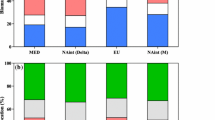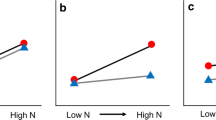Abstract
Hybridization between introduced and related native species has been suggested to be a key driving force of evolutionary processes in invasions that may be accelerated by increasing nitrogen (N) deposition. We carried out two experiments to compare the competitive ability of a newly-reported putative hybrid (Sphagneticola calendulacea × Sphagneticola trilobata) to that of its invasive paternal parent and investigate its response to different N additions. Growth of the hybrid increased by 39.62 ± 15.69 % when grown with the native parent but showed no significant changes when grown with the invasive parent. Growth of invasive S. trilobata showed no significant changes when grown with the other two taxa. The hybrid and invasive parent inhibited the growth of the native parent by 33.27 ± 15.26 % and 78.56 ± 3.13 %, respectively. Low level N addition (50 kg N ha−1) enhanced the growth of both the hybrid and native parent, whereas medium and high levels of N additions (150, 300 kg N ha−1) had no effects on hybrid growth but decreased native parent growth. However, all N treatments had no significant effects on the growth of the invasive parent. Our results suggest that the hybrid is an equal competitor to its invasive parent and is more susceptible to N deposition. Therefore, this hybrid could be a threat to native diversity but may decline more than the invasive parent under high N conditions.





Similar content being viewed by others
References
Abbott RJ (1992) Plant invasions, interspecific hybridization and the evolution of new plant taxa. Trends Ecol Evol 7:401–405. doi:10.1016/0169-5347(92)90020-C
Abbott RJ, James JK, Irwin JA, Comes HP (2000) Hybrid origin of the Oxford ragwort, Senecio squalidus L. Watsonia 23:123–138
Ainouche ML, Baumel A, Salmon A, Yannic G (2003) Hybridization, polyploidy and speciation in Spartina (Poaceae). New Phytol 161:165–172. doi:10.1046/j.1469-8137.2003.00926.x
Anttila CK, Daehler CC, Rank NE, Strong DR (1998) Great male fitness of a rare invader (Spartina alterniflora, Poaceae) threatens a common native (Spartina foliosa) with hybridization. Am J Bot 85:1597–1601
Bleeker W, Schmitz U, Ristow M (2007) Interspecific hybridization between alien and native plant species in Germany and its consequences for native biodiversity. Biol Conserv 137:248–253. doi:10.1016/j.biocon.2007.02.004
Bobbink R, Hicks K, Galloway J, Spranger T, Alkemade R, Ashmore M, Bustamante M, Cinderby S, Davidson E, Dentener F, Emmett B, Erisman JW, Fenn M, Gilliam F, Nordin A, Pardo L, de Vries W (2010) Global assessment of nitrogen deposition effects on terrestrial plant diversity effects of terrestrial ecosystems: a synthesis. Ecol Appl 20:30–59. doi:org/10.1890/08-1140.1
Brooks ML (2003) Effects of increased soil nitrogen on the dominance of alien annual plants in the Mojave Desert. J Appl Ecol 40:344–353. doi:10.1046/j.1365-2664.2003.00789.x
Callaway RM, Ridenour WM, Laboski T, Weir T, Vivanco JM (2005) Natural selection for resistance to the allelopathic effects of invasive plants. J Ecol 93:576–583. doi:10.1111/j.1365-2745.2005.00994.x
Cornelissen JHC, Werger MJA, Castro-Díez P, van Rheenen JWA, Rowland AP (1997) Foliar nutrients in relation to growth, allocation and leaf traits in seedlings of a wide range of woody plant species and types. Oecologia 111:460–469
Ellstrand NC, Schierenbeck KA (2000) Hybridization as a stimulus for the evolution of invasiveness in plants? Proc Natl Acad Sci USA 97:7043–7050
Gress SE, Nichols TD, Northcraft CC, William TP (2007) Nutrient limitation in soils exhibiting differing nitrogen availabilities: what lies beyond nitrogen saturation? Ecology 88:119–130. doi:10.1890/0012-9658(2007)88[119:NLISED]2.0.CO;2
Grosholz E (2010) Avoidance by grazers facilitates spread of an invasive hybrid plant. Ecol Lett 13:145–153. doi:10.1111/j.1461-0248.2009.01409.x
Grotkopp E, Rejmánek M (2007) High seedling relative growth rate and specific leaf area are traits of invasive species: phylogenetically independent contrasts of woody angiosperms. Am J Bot 94:526–532. doi:10.3732/ajb.94.4.526
Güsewell S (2004) N: P ratios in terrestrial plants: variation and functional significance. New Phytol 164:243–266. doi:10.1111/j.1469-8137.2004.01192.x
Hättenschwiler S, Bretscher D (2001) Isopod effects on decomposition of litter produced under elevated CO2, N deposition and different soil types. Global Change Biol 7:565–579. doi:10.1046/j.1365-2486.2001.00402.x
He WM, Yu GL, Sun ZK (2011) Nitrogen deposition enhances Bromus tectorum invasion: biogeographic differences in growth and competitive ability between China and North American. Ecography 34:1059–1066. doi:10.1111/j.1600-0587.2011.06835.x
Hobbie S, Gough L (2002) Foliar and soil nutrients in tundra on glacial landscapes of contrasting ages in northern Alaska. Oecologia 131:453–462. doi:10.1007/s00442-002-0892-x
Houlton BZ, Wang YP, Vitousek PM, Christopher BF (2008) A unifying framework for dinitrogen fixation in the terrestrial biosphere. Nature 454:327–330. doi:10.1038/nature07028
Huenneke LF, Hamburg SP, Koide R, Mooney HA, Vitousek PM (1990) Effects of soil resources on plant invasion and community structure in California serpentine grassland. Ecology 71:478–491. doi:org/10.2307/1940302
James JJ (2008) Leaf nitrogen productivity as a mechanism driving the success of invasive annual grasses under low and high nitrogen supply. J Arid Environ 72:1775–1784. doi:org/10.1016/j.jaridenv.2008.05.001
Krebs C, Gerber E, Matthies D, Schaffner U (2011) Herbivore resistance of invasive Fallopia species and their hybrids. Oecologia 167:1041–1052. doi:10.1007/s00442-011-2035-8
Leishman MR, Thomson VP, Cooke J (2010) Native and exotic invasive plants have fundamentally similar carbon capture strategies. J Ecol 98:28–42. doi:10.1111/j.1365-2745.2009.01608.x
Li ZY, Xie Y (2002) Invasive species in China. China Forest Publishing House, Beijing
Liu JX, Li ZF (2005) Effects of CO2 concentrations increasing on photosynthetic physiological characteristics of Wedelia trilobata. Guihaia 25:477–480
Liu XJ, Duan L, Mo JM, Du EZ, Shen JL, Lu XK, Zhang Y, Zhou XB, He CN, Zhang FS (2011) Nitrogen deposition and its ecological impact in China: an overview. Environ Pollut 159:2251–2264. doi:10.1016/j.envpol.2010.08.002
Lowe PN, Lauenroth WK, Burke IC (2003) Effects of nitrogen availability on competition between Bromus tectorum and Bouteloua gracilis. Plant Ecol 167:247–254
Lv CQ, Tian HQ (2007) Spatial and temporal patterns of nitrogen deposition in China: synthesis of observational data. J Geophys Res 112:D22S05. doi:10.1029/2006JD007990
MacDonald JA, Dise NB, Matzner E, Armbruster M, Gundersen P (2002) Nitrogen input together with ecosystem nitrogen enrichment predict nitrate leaching from European forests. Global Change Biol 8:1028–1033. doi:10.1046/j.1365-2486.2002.00532.x
Maskell LC, Smart SM, Bullock JM, Thompson K, Stevens CJ (2010) Nitrogen deposition causes widespread loss of species richness in British habitats. Global Change Biol 16:71–679. doi:10.1111/j.1365-2486.2009.02022.x
Mo JM, Zhang W, Zhu WX, Gundersen P, Fang YT, Li DJ, Wang H (2008) Nitrogen addition reduces soil respiration in a mature tropical forest in southern China. Global Change Biol 14:03–412. doi:10.1111/j.1365-2486.2007.01503.x
Nakaji T, Fukami M, Dokiya Y, Izuta T (2001) Effects of high nitrogen load on growth, photosynthesis and nutrient status of Cryptomeria japonica and Pinus densiflora seedlings. Trees 15:453–461
Ni GY, Schaffner U, Peng SL, Callaway RM (2010) Acroptilon repens, an Asian invader, has stronger competitive effects on species from America than species from its native range. Biol Invasions 12:3653–3663. doi:10.1007/s10530-010-9759-y
Poorter L (1999) Growth responses of 15 rain-forest tree species to a light gradient: the relative importance of morphological and physiological traits. Funct Ecol 13:96–410. doi:10.1046/j.1365-2435.1999.00332.x
Poorter L, Van de Plassche M, Willems S, Boot RGA (2004) Leaf traits and herbivory rates of tropical tree species differing in successional status. Plant Biol 6:746–754. doi:10.1055/s-2004-821269
Pyšek P, Danihelka J, Sádlo J, Chrtek J Jr, Chytrý M, Jarošík V, Kaplan Z, Krahulec F, Moravcová L, Pergl J, Štajerová K, Tichý L (2012) Catalogue of alien plants of the Czech Republic (2nd): checklist update, taxonomic diversity and invasion patters. Preslia 84:55–255
Rastetter EB, Kwiatkowski BL, Le Dizès S, Hobbie JE (2004) The role of down-slope water and nutrient fluxes in the response of Arctic hill slopes to climate change. Biogeochemistry 69:37–62
Ren R, Mi FJ, Bai NB (2000) A chemometrics analysis on the data of precipitation chemistry of China. J Beijing Polytechnic University 26:90–95
Rickey MA, Anderson RC (2004) Effects of nitrogen addition on the invasive grass Phragmites australis and a native competitor Spartina pectinata. J Appl Ecol 41:88–896. doi:10.1111/j.0021-8901.2004.00948.x
Schierenbeck KA, Ellstrand NC (2009) Hybridization and the evolution of invasiveness in plants and other organisms. Biol Invasions 11:1093–1105. doi:10.1007/s10530-008-9388-x
Song LY, Li CH, Peng SL (2010) Elevated CO2 increases energy-use efficiency of invasive Wedelia trilobata over its indigenous congener. Biol Invasions 12:1221–1230. doi:10.1007/s10530-009-9541-1
Tanaka Y (2007) Introgressive hybridization as the breakdown of postzygotic isolation: a theoretical perspective. Ecol Res 22:929–939. doi:10.1007/s11284-007-0384-x
Tomassen HBM, Smolders AJP, Limpens J, Lamers LPM, Roelofs JGM (2004) Expansion of invasive species on ombrotrophic bogs: desiccation or high N deposition? J Appl Ecol 41:139–150
Tu LH, Hu HL, Hu TX, Zhang J, Liu L, Li RH, Dai HZ, Luo SH (2011) Decomposition of different litter fractions in a subtropical bamboo ecosystem as affected by experimental nitrogen deposition. Pedosphere 21:685–695
Vasquez E, Sheley R, Svejcar T (2008) Nitrogen enhances the competitive ability of cheatgrass (Bromus tectorum) relative to native grasses. Invasive plant Sci Manag 1:287–295
Vilà M, Weiner J (2004) Are invasive plant species better competitors than native plant species? Evidence from pair-wise experiments. Oikos 105:229–238. doi:10.1111/j.0030-1299.2004.12682.x
Vilà M, Weber E, D’Antonio CM (2000) Conservation implications of invasion by plant hybridization. Biol Invasions 2:207–217
Vilà M, Corbin JD, Dukes JS, Pino J, Smith SD (2007) Linking plant invasions to global environmental change. In: Canadell JJ, Pataki DE, Pitelka LF (eds) Terrestrial ecosystems in a changing world. The IGBP series, Part B. Springer, Berlin, pp 93–102
Vitousek PM, Howarth RW (1991) Nitrogen limitation on land and in the sea: how can it occur? Biogeochemistry 13:87–115
Wu YQ, Hu YJ, Chen JN (2005) Reproductive characteristics of alien plant Wedelia trilobata. Acta Scientiarum Naturalium Universitatis Sunyatseni 44:93–96
Wu W, Zhou RC, Ni GY, Shen H, Ge XJ (2013) Is a new invasive herb emerging? Molecular confirmation and preliminary evaluation of natural hybridization between the invasive Sphagneticola trilobata (Asteracear) and its native congener S. calendulacea in South China. Biol Invasions 15:75–88. doi:10.1007/s10530-012-0269-y
Zhi YB, Li HL, An SQ, Zhao L, Zhou CF, Deng ZF (2007) Inter-specific competition: Spartina alterniflora is replacing Spartina anglica in coastal China. Estuar Coast Shelf Sci 74:437–448
Zhu LW, Zhao P, Cai XA, Zeng XP, Ni GY, Zhang JY, Zou LL, Mei TT, Yu MH (2012) Effects of sap velocity on the daytime increase of stem CO2 efflux from stems of Schima superba trees. Trees 26:535–542. doi:10.1007/s00468-011-0615-1
Acknowledgments
We are particularly indebted to G Li for his helpful discussions and comments on the manuscript. We thank Q-Q Huang, Y-P Hou, B-M Chen for their valuable comments and suggestions on earlier versions of this manuscript. This study was supported by grants from the Natural Science Foundation of China (31200380, 41030638), the Knowledge Innovation Program of the CAS (KSCX2-EW-J-28), and the Natural Science Foundation of Guangdong Province (S2011040000331).
Author information
Authors and Affiliations
Corresponding author
Electronic supplementary material
Below is the link to the electronic supplementary material.
About this article
Cite this article
Ni, G., Zhao, P., Wu, W. et al. A hybrid of the invasive plant Sphagneticola trilobata has similar competitive ability but different response to nitrogen deposition compared to parent. Ecol Res 29, 331–339 (2014). https://doi.org/10.1007/s11284-014-1130-9
Received:
Accepted:
Published:
Issue Date:
DOI: https://doi.org/10.1007/s11284-014-1130-9




